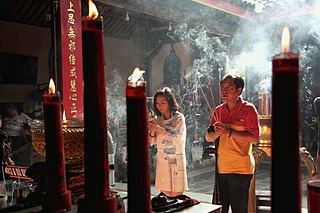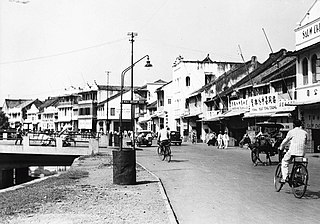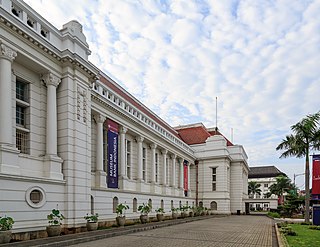
The United East India Company was a chartered company established on 20 March 1602 by the States General of the Netherlands amalgamating existing companies into the first joint-stock company in the world, granting it a 21-year monopoly to carry out trade activities in Asia. Shares in the company could be bought by any resident of the United Provinces and then subsequently bought and sold in open-air secondary markets. It is sometimes considered to have been the first multinational corporation. It was a powerful company, possessing quasi-governmental powers, including the ability to wage war, imprison and execute convicts, negotiate treaties, strike its own coins, and establish colonies.

Chinese Indonesians, colloquially Cindo, Chindo or simply Orang Tionghoa or Tionghoa are Indonesians whose ancestors arrived from China at some stage in the last eight centuries. Chinese Indonesians are the fourth largest community of Overseas Chinese in the world after Thailand, Malaysia, and the United States.
The Anglo-Dutch Treaty of 1824, also known as the Treaty of London, was a treaty signed between the United Kingdom and the Netherlands in London on 17 March 1824. The treaty was to resolve disputes arising from the execution of the Anglo-Dutch Treaty of 1814. For the Dutch, it was signed by Hendrik Fagel and Anton Reinhard Falck, and for the British, George Canning and Charles Williams-Wynn.

Batavia was the capital of the Dutch East Indies. The area corresponds to present-day Jakarta, Indonesia. Batavia can refer to the city proper or its suburbs and hinterland, the Ommelanden, which included the much larger area of the Residency of Batavia in the present-day Indonesian provinces of Jakarta, Banten and West Java.

The Netherlands Indies guilder was the unit of account of the Dutch East Indies from 1602 under the United East India Company, following Dutch practice first adopted in the 15th century. A variety of Dutch, Spanish and Asian coins were in official and common usage. After the collapse of the VOC at the end of the 18th century, control of the islands reverted to the Dutch government, which issued silver 'Netherlands Indies' guilder and fractional silver and copper coins until Indonesian independence in 1945.
Armenians in the Netherlands are the ethnic Armenians living in the Netherlands. The number of Armenians living in the country is around 40.000, according to the Armenian ambassador.

Oei Tiong Ham, Majoor-titulair der Chinezen was a Chinese Indonesian tycoon and the son of Oei Tjie Sien, the founder of the Kian Gwan, a multinational trading company. Born in Semarang, Central Java, Dutch East Indies, he became the wealthiest person in Asia at the start of the twentieth century. Part of his wealth originated in his involvement in the sugar industry. He served as Luitenant der Chinezen in the Dutch colonial administration in Semarang, and was raised to the rank of titular Majoor upon retirement.
George Manook ;, was an Armenian merchant of Java, was among the richest figures in the Dutch East Indies, and on several occasions lent large sums of money to the Dutch government. He left behind a fortune of five million guilders when he died.

The Banten Sultanate was a Bantenese Islamic trading kingdom founded in the 16th century and centred in Banten, a port city on the northwest coast of Java; the contemporary English name of both was Bantam. It is said to have been founded by Sunan Gunungjati, who had previously founded Cirebon.

Company rule in the Dutch East Indies began when the Dutch East India Company appointed the first governor-general of the Dutch East Indies in 1610, and ended in 1800 when the bankrupt company was dissolved and its possessions were nationalized as the Dutch East Indies. By then it exerted territorial control over much of the archipelago, most notably on Java.

Kapitan Cina, also spelled Kapitan China or Capitan China, was a high-ranking government position in the civil administration of colonial Indonesia, Malaysia, Singapore, Borneo and the Philippines. Office holders exercised varying degrees of power and influence: from near-sovereign political and legal jurisdiction over local Chinese communities, to ceremonial precedence for community leaders. Corresponding posts existed for other ethnic groups, such as Kapitan Arab and Kapitan Keling for the local Arab and Indian communities respectively.

The Dutch East Indies, also known as the Netherlands East Indies, was a Dutch colony with territory mostly comprising the modern state of Indonesia, which declared independence on 17 August 1945. Following the Indonesian War of Independence, Indonesia and the Netherlands made peace in 1949. In the Anglo-Dutch Treaty of 1824, the Dutch ceded the governorate of Dutch Malacca to Britain, leading to its eventual incorporation into Malacca (state) of modern Malaysia.

Armenians first traveled to Java towards the end of the 18th century. They established several well-known commercial houses engaged in trade with overseas markets.

The economic history of Indonesia is shaped by its geographic location, its natural resources, as well as its people that inhabited the archipelago that today formed the modern nation-state of the Republic of Indonesia. The foreign contact and international trade with foreign counterparts had also shaped and sealed the fate of Indonesian archipelago, as Indians, Chinese, Arabs, and eventually European traders reached the archipelago during the Age of Exploration and participated in the spice trade, war and conquest.

Ambon was a governorate of the Dutch East India Company, consisting of Ambon Island and ten neighbouring islands. Steven van der Hagen captured Fort Victoria on 22 February 1605 from the Portuguese in the name of the Dutch East India Company. Until 1619, Ambon served as the capital of the Dutch possessions in East Asia. In that year Batavia was founded to function as the staple port for the Dutch East India Company in Asia. The island was the world center of clove production until the 19th century. The Dutch prohibited the rearing of the clove-tree in all the other islands subject to their rule, in order to secure the monopoly to Ambon.
Kian Gwan (Chinese: 建源; pinyin: Jiànyuán; Pe̍h-ōe-jī: Kiàn-goân) was the largest multinational trading company in Southeast Asia in the early decades of the twentieth century, and was founded in 1863 in the Dutch East Indies (now Indonesia). It survives today as a diversified group in Thailand. and in Indonesia, being nationalized in 1961, as PT Rajawali Nusantara Indonesia (Persero).

The Bank of Java was a note-issuing bank in the Dutch East Indies, founded in 1828, and nationalized in 1951 by the government of Indonesia to become the newly independent country’s central bank, later renamed Bank Indonesia. For more than a century, the Bank of Java was the central institution of the Dutch East Indies’ financial system, alongside the “big three” commercial banks. It was both a note-issuing bank and a commercial bank.

Tio Tek Ho, 4th Majoor der Chinezen was an ethnic Chinese bureaucrat in the Dutch East Indies who served as the fourth and penultimate Majoor der Chinezen or Chinese headman of Batavia, now Jakarta, capital of Indonesia. This was the most senior position in the Chinese officership, which constituted the Chinese arm of the civil bureaucracy in the Dutch East Indies. As Majoor, Tio was also the ex officio Chairman of the Chinese Council of Batavia, the city's highest Chinese government body.

The Cabang Atas —literally 'highest branch' in Indonesian—was the traditional Chinese establishment or gentry of colonial Indonesia. They were the families and descendants of the Chinese officers, high-ranking colonial civil bureaucrats with the ranks of Majoor, Kapitein and Luitenant der Chinezen. They were referred to as the baba bangsawan [‘Chinese gentry’] in Indonesian, and the ba-poco in Java Hokkien.

The Nederlandsch-Indische Escompto Maatschappij was a significant Dutch bank, founded in 1857 in Batavia, Dutch East Indies. In the first half of the 20th century, it was the smallest of the “big three” commercial banks, behind the Netherlands Trading Society and the Nederlandsch-Indische Handelsbank, that dominated the Dutch East Indies’ financial system alongside the note-issuing Bank of Java.

















